Wild things living in my garden
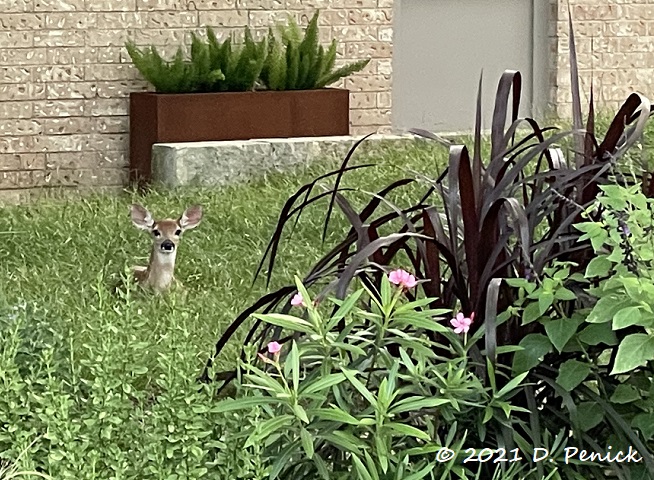
A month ago I spotted twin newborn fawns in my front garden. They’re still out there most days, only they’re much bigger now and will take flight rather than crouch and hide. The bold one watches warily if we come outside while it’s enjoying an evening lie-down in the sedge lawn.
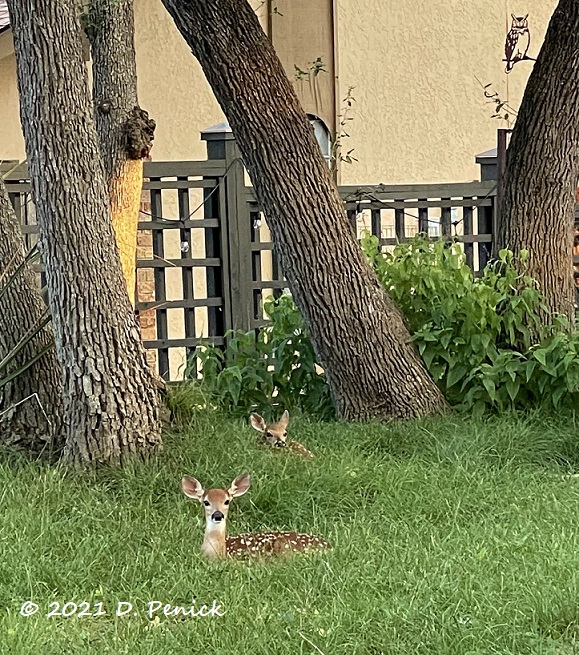
Here he/she is again, a veritable Loch Sedge monster. Shall I name it Nessie? Its timid sibling tends to keep its head down, hoping not to be noticed.
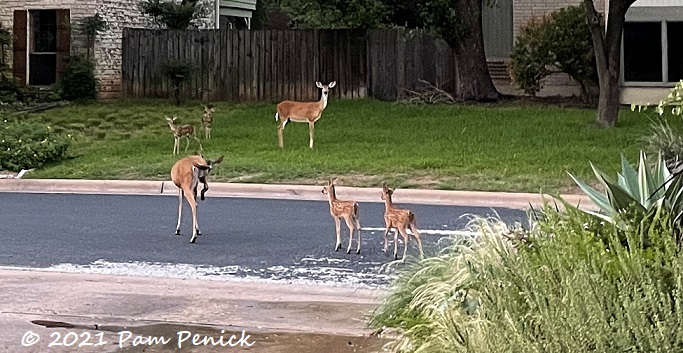
A couple weeks ago I popped outside one evening to check on a sprinkler and found two does, each with a set of twins, attracted by the water. (This is why I don’t have an ornamental fountain or birdbath in the front garden. I’d rather deer stay wild and avoid enticing a herd of them into my garden every day.) They crossed the street, and I kept my distance too, not wanting to alarm the protective does.
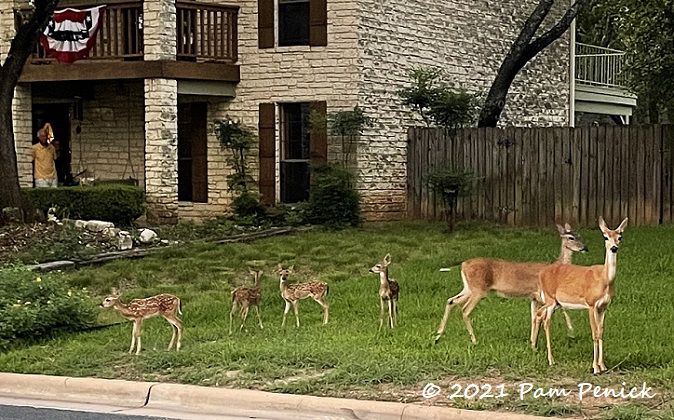
They are awfully cute when they’re babies. But as Frank Hyman points out in a recent article in the Wall Street Journal, “Urban-adjacent deer multiply at the expense of forest tree seedlings, songbirds and native plants…” Click through for a less “Aww, Bambi!” perspective than mine.
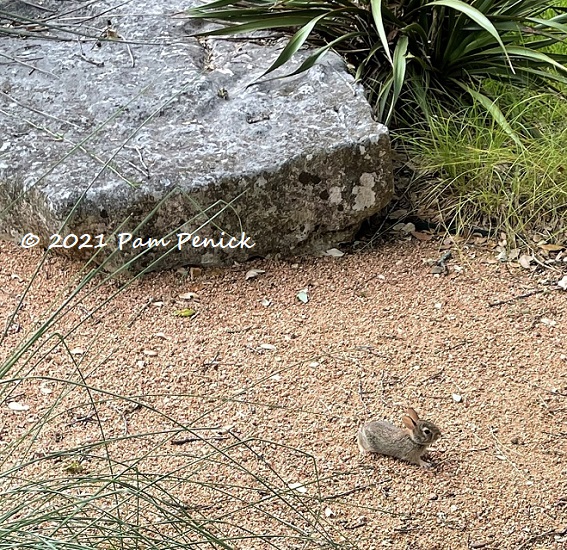
Speaking of adorable but voracious, I saw a cute baby rabbit in the garden one day. Rabbits are also a pest in sufficient numbers. Still, I hope that nature will keep things in balance. I found one young rabbit half-eaten a few months ago, right after I’d seen a hawk flying over the garden. We also have great horned owls and screech owls and, lately, a raven. Coyotes too. Run fast, little bunny.
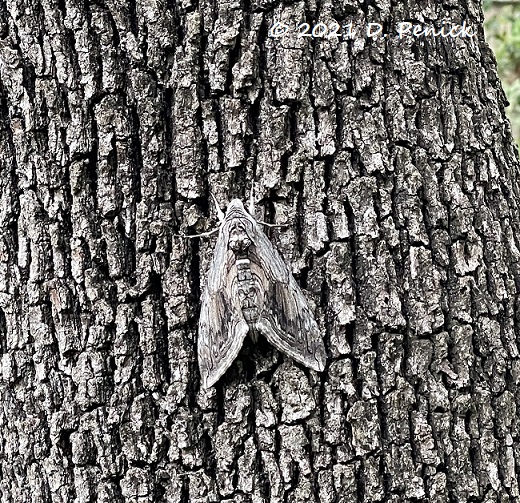
One of the biggest moths I’ve seen flew by one evening and landed on a live oak trunk, where it was well camouflaged. Austin entomologist Wizzie Brown ID’d it on my Instagram post as a five-spotted hawk moth.
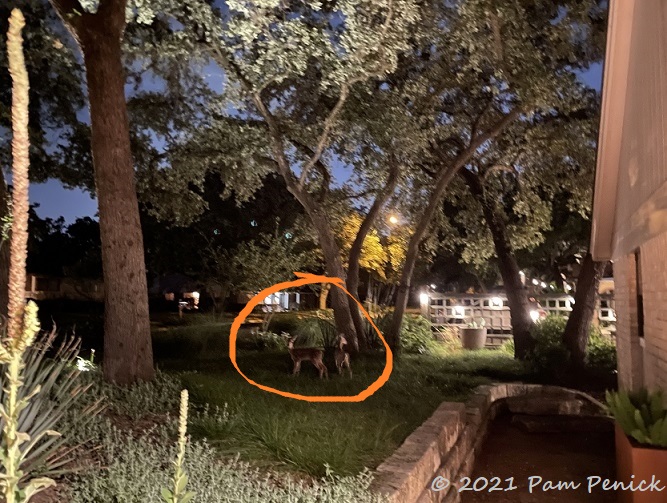
But always it comes back to deer in my garden. Here are the twins hanging out in the sedge lawn late one evening. I’d gone out to photograph a datura in bloom and startled them. What I could hardly see in the dark my iPhone camera picked up pretty well. They’d stood up and were deciding whether to make a run for it. No need, little guys. You’ve trained me to give you as much of the front garden as you need for a safe place to lounge. Just don’t even think about trying to get into the back garden.
__________________________
Digging Deeper
Come learn about gardening and design at Garden Spark! I organize in-person talks by inspiring designers, landscape architects, authors, and gardeners a few times a year in Austin. These are limited-attendance events that sell out quickly, so join the Garden Spark email list to be notified in advance; simply click this link and ask to be added. Season 8 kicks off in fall 2024. Stay tuned for more info!
All material © 2025 by Pam Penick for Digging. Unauthorized reproduction prohibited.


You are much more accepting of those wild critters than I have been lately!
I do my share of fist shaking for the damage they do, believe me. But the babies are just too cute to be mad about.
It’s much easier to accept the critters in photos of someone else’s garden. I can’t imagine dealing with deer – the raccoons and rabbits are bad enough. Rabbits didn’t show up here until 3 years ago (even based on the recollections of neighbors who’ve lived here decades longer than I have) and the first 2 years it seemed that the coyotes “redirected” them elsewhere by mid-spring but now there are legions of them. Whether that’s simply the result of a population explosion, or due to the removal of coyotes due to complaints about the loss of small pets, I can’t say. At least the peacocks steered clear of us this year.
That is true, Kris. Animals are always cuter in other people’s gardens. Legions of rabbits sounds pretty awful. Deer are bad. But I sometimes tell myself, at least I don’t have moose. Or bears. Or elephants!
Surely you’ve got armadillos. They are showing up in regular numbers here in mid-state Georgia now. Soon they will populate the Arctic.
Twin and triplet fawns are a sign of overpopulation and loss of predators. Surprising, since you’ve still got coyotes around.
Your blog posts are such a treat. Thanks, Pam!
Oh yes, lots of armadillos. They don’t do much damage in my garden anymore because it’s established. Newly planted gardens suffer the most when armadillos come tunneling for earthworms and grubs.
I’d read in Frank Hyman’s article (linked in my post) about twins and triplets being a sign of deer overpopulation. It only takes a morning or dusk drive around my northwest Austin neighborhood to tell you we have an incredible overpopulation of deer. It’s a problem, not just for people but plants (native plants in the greenbelts too) and the deer. As for coyotes, I’ve no idea of their numbers, but we see one occasionally (and neighbors post pics on our FB group) and fairly often hear them howling in the greenbelt. But there are so many deer they have their work cut out for them.
I also live in NW Austin. I am trying to gradually convert my front landscaping to deer proof/deer discouraging plants. Many of the things marked deer resistant by the “experts” are just tasty treats for our NW Austin deer. Can you name some of your favorites as well as the things you have had best luck with in your front spaces where the deer come to play? My yard is turning into a mullet haircut – business in the front, party in the back! Thanks for the blog – really enjoy your stories and learn something every time I check it out.
Well, deer-ridden yards do have to be a little more restrained in plant choice by necessity. Alas. 🙂
But there are still lots of things to try out with your deer population. Each group can be different in what they will eat. For me, herbs with scented leaves, grasses, fibrous plants like yucca and nolina, and a few others do well. My faves are bamboo muhly, ‘Pink Flamingos’ muhly, sedges like lawn sedge from Barton Springs Nursery and ‘Everillo’ sedge, any salvia but esp. Salvia greggii and ‘Amistad’ salvia, rosemary, Mexican oregano, dwarf Texas palmetto, golden thryallis, vitex, Brazilian rock rose, variegated dianella, any yucca but esp. Yucca pallida and ‘Bright Edge’, Texas sotol, Wheelers sotol, Turk’s cap, heartleaf skullcap, purple skullcap, garlic chives, lamb’s ear, and Jerusalem sage. You can find botanical names for all of these in my plant list in the top menu.
Thanks so much. I am determined to learn to co-exist with these critters, since it is clear they are not going anywhere.
Heads-up that the larva of the five-spotted hawk moth is the tomato hornworm!
I’ve found a couple of tomato hornworms in my yard this summer & I’m not growing tomatoes or any other nightshade plants that they also eat, so maybe my neighbors are or maybe we’ve got some of the weeds that they also eat hiding somewhere.
Yes, that’s true. No tomatoes here in my garden though. I’m not sure if it would lay eggs on something regardless.
Just saw your post on your beautiful datura–so lovely! Because they’re also in the Solanaceae family, they’re also host plants to hornworms/five-spotted hawk moth. Just found all this out thanks to your posts which caused me to dig for more info, come back to them when I’ve needed a resource, or share with friends! Thank you for always educating & inspiring us! I’ve loved your blog for years & years but just recently started leaving comments. So, so thankful for all!
Thanks for reading and commenting, Kate! We all learn from each other. 🙂